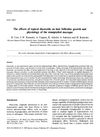Quantitative Models for the Study of Hair Growth in Vivoa
December 1991
in “Annals of the New York Academy of Sciences”

TLDR The conclusion is that small hair follicles cause baldness in macaques, and treatments like antiandrogens and minoxidil can prevent hair loss and promote regrowth.
In 1991, researchers developed a quantitative method to study hair growth in vivo, focusing on the histogenesis of baldness in stumptailed macaques and using a morphometric method to create "folliculograms." They discovered that alopecia in macaques was due to smaller hair follicles, not fewer in number, and was linked to puberty and increased androgen levels. The condition could be prevented with antiandrogens. The study also found that 5% minoxidil was more effective than 2% in promoting hair regrowth and follicle size. A study with six macaques treated with an antiandrogen showed decreased 5α-reductase activity, unchanged serum androgens, and increased hair weight, preventing frontal baldness. Additionally, minoxidil treatment in fuzzy rats, a genetic model for hair growth, increased the size of anagen follicles and stimulated growth in dormant vellus telogen follicles. The document concludes that vellus follicles have the potential for regrowth, but continuous androgen effects can cause regression unless blocked locally. The macaque and rat models were deemed relevant for studying human androgenetic alopecia and for drug screening.
View this study on nyaspubs.onlinelibrary.wiley.com →
Cited in this study

research The effects of topical diazoxide on hair follicular growth and physiology of the stumptailed macaque
Diazoxide applied to the skin can increase hair growth without harmful side effects.

research The stumptailed macaque as a model for androgenetic alopecia: Effects of topical minoxidil analyzed by use of the folliculogram
The study used monkeys to test a hair loss treatment called minoxidil, which showed positive results.

research Action of topical minoxidil in the bald stump-tailed macaque
Minoxidil promotes hair growth but stops working when discontinued.

research Cyclic dynamics of hair follicles and the effect of minoxidil on the bald scalps of stumptailed macaques
Minoxidil helps grow longer, thicker hair in bald scalps of stumptailed macaques, and early treatment is more effective.

research Effect of Minoxidil on Cultured Keratinocytes
Minoxidil helps hair cells live longer and grow longer.